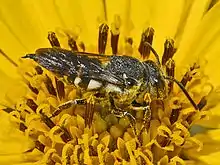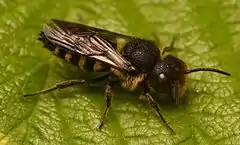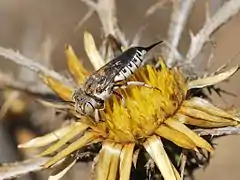Coelioxys
Coelioxys, common name leaf-cutting cuckoo bees or sharp-tailed bees , is a genus of solitary kleptoparasitic or brood parasitic bees, belonging to the family Megachilidae.
| Coelioxys | |
|---|---|
 | |
| Female of Coelioxys species | |
| Scientific classification | |
| Kingdom: | Animalia |
| Phylum: | Arthropoda |
| Class: | Insecta |
| Order: | Hymenoptera |
| Family: | Megachilidae |
| Subfamily: | Megachilinae |
| Genus: | Coelioxys Latreille, 1809 |
| Subgenera | |
Selected species
- Coelioxys angulata
- Coelioxys apicata
- Coelioxys capitata
- Coelioxys fenestrata
- Coelioxys formosicola
- Coelioxys fuscipennis
- Coelioxys minuta
- Coelioxys nitidoscutellaris
- Coelioxys rufitarsis
- Coelioxys sodalis
For a complete list, see List of Coelioxys species.
Distribution
Coelioxys species can be found in most European countries, in the Afrotropical realm, in the East Palearctic realm, in North Africa, in the Nearctic and Neotropics.[3][1]
Description
Bees within this genus can reach a length of 8–12 millimetres (0.31–0.47 in). They show a broad head with large complex eyes and broad thorax and abdomen. Their body is only moderately hairy. They are usually black with white hair stripes. Legs maybe red or black. The females of Coelioxys species have a long pointed abdomen that resembles a cone, used to pierce the leaf lining in the laying of eggs. The male's abdomen is armed with spines or teeth.[1]
They are known to sometimes sleep upside down on vegetation.[4]
Biology
These cuckoo bees are usually active from June to September, depending on the specific host species. They have no pollen-carrying adaptations, as they do not need to provision nests. Adults feed on nectar at flowers of a wide range of different nectar plants. In fact they mainly lay their eggs in the nests of bees in the genus Megachile, but also in the nests of Osmia and Anthophora, on their provisions of pollen. As this behavior is similar to that of cuckoos, such bees are sometimes referred to as "cuckoo bees". These host-parasite relationships are quite complex. The larvae of Coelioxys species kill the host larvae with their strongly developed mandibles and feed on the host’s pollen provisions. They spin a cocoon at 11–16 days. These species are usually univoltine, but for some species a second generation is possible.[1][5]
Gallery
 Coelioxys rufescens
Coelioxys rufescens Coelioxys acanthura
Coelioxys acanthura Coelioxys inermis
Coelioxys inermis.jpg.webp)
References
- "Genus Coelioxys - Cuckoo-leaf-cutter Bees". BugGuide.net. Retrieved 5 October 2014.
- "ITIS Standard Report Page: Coelioxys". Retrieved 25 November 2014.
- Fauna europaea
- Emry, Paige. Our Native Bees. p. 79.
- "Bees of the Week: genus Coelioxys". The bees needs. Retrieved 6 October 2014.
- Baker, J. R. 1975. Taxonomy of five nearctic subgenera of Coelioxys (Hymenoptera: Megachilidae). University of Kansas Science Bulletin 50: 649-730.